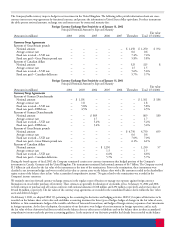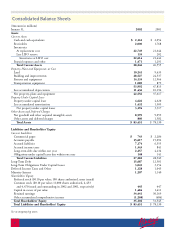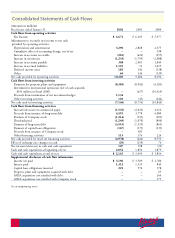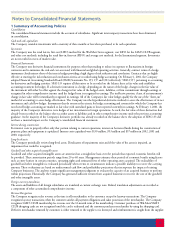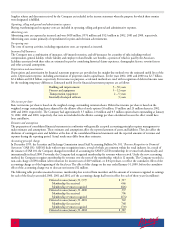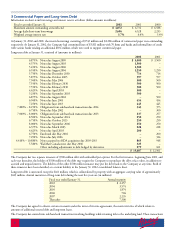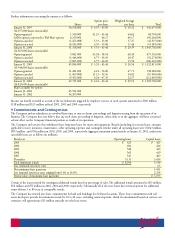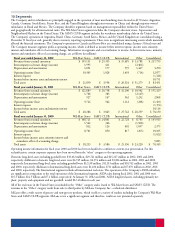Walmart 2002 Annual Report Download - page 30
Download and view the complete annual report
Please find page 30 of the 2002 Walmart annual report below. You can navigate through the pages in the report by either clicking on the pages listed below, or by using the keyword search tool below to find specific information within the annual report.
28
1 Summary of Accounting Policies
Consolidation
The consolidated financial statements include the accounts of subsidiaries. Significant intercompany transactions have been eliminated
in consolidation.
Cash and cash equivalents
The Company considers investments with a maturity of three months or less when purchased to be cash equivalents.
Inventories
The Company uses the retail last-in, first-out (LIFO) method for the Wal-Mart Stores segment, cost LIFO for the SAM’S CLUB segment,
and other cost methods, including the retail first-in, first-out (FIFO) and average cost methods, for the International segment. Inventories
are not recorded in excess of market value.
Financial Instruments
The Company uses derivative financial instruments for purposes other than trading to reduce its exposure to fluctuations in foreign
currencies and to minimize the risk and cost associated with financial and global operating activities. Generally, contract terms of a hedge
instrument closely mirror those of the item it hedges providing a high degree of risk reduction and correlation. Contracts that are highly
effective at meeting the risk reduction and correlation criteria are recorded using hedge accounting. On February 1, 2001, the Company
adopted Financial Accounting Standards Board (FASB) Statements No. 133, 137 and 138 (collectively “SFAS 133”) pertaining to accounting
for derivatives and hedging activities. SFAS 133 requires all derivatives to be recorded on the balance sheet at fair value and establishes
accounting treatment for hedges. If a derivative instrument is a hedge, depending on the nature of the hedge, changes in the fair value of
the instrument will either be offset against the change in fair value of the hedged assets, liabilities, or firm commitment through earnings or
recognized in other comprehensive income until the hedged item is recognized in earnings. The ineffective portion, if any, of an instrument’s
change in fair value will be immediately recognized in earnings. All of the Company’s fair value hedges qualify for the use of the “short-cut”
method of accounting to assess hedge effectiveness. The Company uses the hypothetical derivative method to assess the effectiveness of its net
investment and cash flow hedges. Instruments that do not meet the criteria for hedge accounting and contracts for which the Company has
not elected hedge accounting are marked to fair value with unrealized gains or losses reported currently in earnings. At February 1, 2001, the
majority of the Company’s derivatives were hedges of net investments in foreign operations. As such, the fair value of these derivatives had
already been recorded on the balance sheet as either assets or liabilities and in other comprehensive income under the previous accounting
guidance. As the majority of the Company’s derivative portfolio was already recorded on the balance sheet, the adoption of SFAS 133 did
not have a material impact on the Company’s consolidated financial statements.
Interest during construction
For interest costs to properly reflect only that portion relating to current operations, interest on borrowed funds during the construction of
property, plant and equipment is capitalized. Interest costs capitalized were $130 million, $93 million and $57 million in 2002, 2001 and
2000, respectively.
Long-lived assets
The Company periodically reviews long-lived assets. If indicators of impairments exist and if the value of the assets is impaired, an
impairment loss would be recognized.
Goodwill and other acquired intangible assets
Goodwill and other acquired intangible assets are amortized on a straight-line basis over the periods that expected economic benefits will
be provided. These amortization periods range from 20 to 40 years. Management estimates these periods of economic benefit using factors
such as entry barriers in certain countries, operating rights and estimated lives of other operating assets acquired. The realizability of
goodwill and other intangibles is evaluated periodically when events or circumstances indicate a possible inability to recover the carrying
amount. These evaluations are based on undiscounted cash flow and profitability projections that incorporate the impact of existing
Company businesses. The analyses require significant management judgment to evaluate the capacity of an acquired business to perform
within projections. Historically, the Company has generated sufficient returns from acquired businesses to recover the cost of the goodwill
and other intangible assets.
Foreign currency translation
The assets and liabilities of all foreign subsidiaries are translated at current exchange rates. Related translation adjustments are recorded as
a component of other accumulated comprehensive income.
Revenue Recognition
The Company recognizes sales revenue at the time it sells merchandise to the customer, except for layaway transactions. The Company
recognizes layaway transactions when the customer satisfies all payment obligations and takes possession of the merchandise. The Company
recognizes SAM’S CLUB membership fee revenue over the 12-month term of the membership. Customer purchases of Wal-Mart/SAM’S
CLUB shopping cards are not recognized until the card is redeemed and the customer purchases merchandise by using the shopping card.
Defective merchandise returned by customers is either returned to the supplier or is destroyed and reimbursement is sought from the supplier.
Notes to Consolidated Financial Statements






